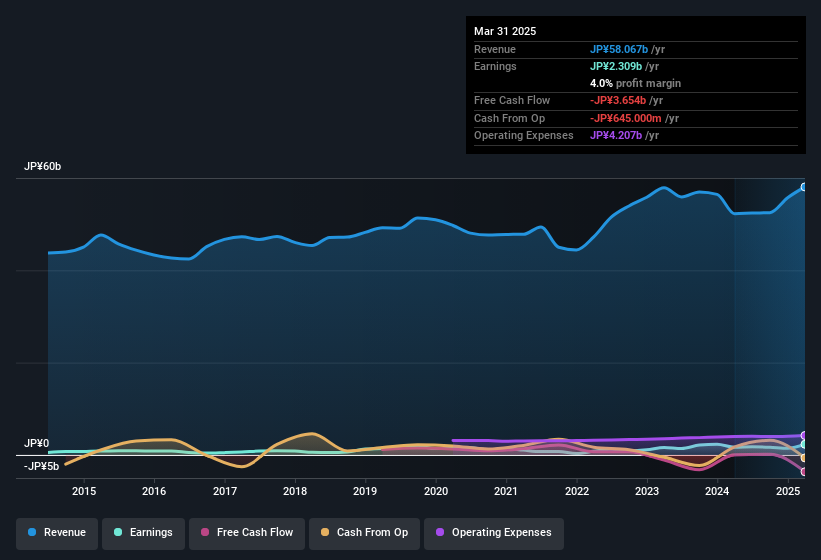Despite posting some strong earnings, the market for Takada Corporation's (TSE:1966) stock hasn't moved much. Our analysis suggests that this might be because shareholders have noticed some concerning underlying factors.
We've discovered 4 warning signs about Takada. View them for free.
A Closer Look At Takada's Earnings
Many investors haven't heard of the accrual ratio from cashflow, but it is actually a useful measure of how well a company's profit is backed up by free cash flow (FCF) during a given period. To get the accrual ratio we first subtract FCF from profit for a period, and then divide that number by the average operating assets for the period. This ratio tells us how much of a company's profit is not backed by free cashflow.
Therefore, it's actually considered a good thing when a company has a negative accrual ratio, but a bad thing if its accrual ratio is positive. While having an accrual ratio above zero is of little concern, we do think it's worth noting when a company has a relatively high accrual ratio. That's because some academic studies have suggested that high accruals ratios tend to lead to lower profit or less profit growth.
Over the twelve months to March 2025, Takada recorded an accrual ratio of 0.27. Unfortunately, that means its free cash flow fell significantly short of its reported profits. Over the last year it actually had negative free cash flow of JP¥3.7b, in contrast to the aforementioned profit of JP¥2.31b. We saw that FCF was JP¥49m a year ago though, so Takada has at least been able to generate positive FCF in the past. Notably, the company has issued new shares, thus diluting existing shareholders and reducing their share of future earnings.
Note: we always recommend investors check balance sheet strength. Click here to be taken to our balance sheet analysis of Takada.
In order to understand the potential for per share returns, it is essential to consider how much a company is diluting shareholders. Takada expanded the number of shares on issue by 16% over the last year. As a result, its net income is now split between a greater number of shares. To talk about net income, without noticing earnings per share, is to be distracted by the big numbers while ignoring the smaller numbers that talk to per share value. Check out Takada's historical EPS growth by clicking on this link.
A Look At The Impact Of Takada's Dilution On Its Earnings Per Share (EPS)
Takada has improved its profit over the last three years, with an annualized gain of 198% in that time. And the 38% profit boost in the last year certainly seems impressive at first glance. On the other hand, earnings per share are only up 37% in that time. Therefore, the dilution is having a noteworthy influence on shareholder returns.
Changes in the share price do tend to reflect changes in earnings per share, in the long run. So it will certainly be a positive for shareholders if Takada can grow EPS persistently. But on the other hand, we'd be far less excited to learn profit (but not EPS) was improving. For that reason, you could say that EPS is more important that net income in the long run, assuming the goal is to assess whether a company's share price might grow.
Our Take On Takada's Profit Performance
In conclusion, Takada has weak cashflow relative to earnings, which indicates lower quality earnings, and the dilution means its earnings per share growth is weaker than its profit growth. For the reasons mentioned above, we think that a perfunctory glance at Takada's statutory profits might make it look better than it really is on an underlying level. If you want to do dive deeper into Takada, you'd also look into what risks it is currently facing. Every company has risks, and we've spotted 4 warning signs for Takada (of which 1 is concerning!) you should know about.
In this article we've looked at a number of factors that can impair the utility of profit numbers, and we've come away cautious. But there is always more to discover if you are capable of focussing your mind on minutiae. Some people consider a high return on equity to be a good sign of a quality business. While it might take a little research on your behalf, you may find this free collection of companies boasting high return on equity, or this list of stocks with significant insider holdings to be useful.
Valuation is complex, but we're here to simplify it.
Discover if Takada might be undervalued or overvalued with our detailed analysis, featuring fair value estimates, potential risks, dividends, insider trades, and its financial condition.
Access Free AnalysisHave feedback on this article? Concerned about the content? Get in touch with us directly. Alternatively, email editorial-team (at) simplywallst.com.
This article by Simply Wall St is general in nature. We provide commentary based on historical data and analyst forecasts only using an unbiased methodology and our articles are not intended to be financial advice. It does not constitute a recommendation to buy or sell any stock, and does not take account of your objectives, or your financial situation. We aim to bring you long-term focused analysis driven by fundamental data. Note that our analysis may not factor in the latest price-sensitive company announcements or qualitative material. Simply Wall St has no position in any stocks mentioned.
About TSE:1966
Takada
Engages in the plant, engineering, plant diagnosis, and electronics equipment businesses in Japan and internationally.
Adequate balance sheet average dividend payer.
Market Insights
Community Narratives




